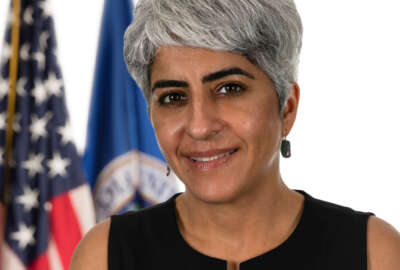

The Office of Personnel Management still has a lot of rebuilding to do. The Trump administration tried to roll its functions into the White House and GSA.
The Office of Personnel Management still has a lot of rebuilding to do. The Trump administration tried to roll its functions into the White House and GSA. The Federal Drive with Tom Temin guest in this interview, points out that OPM went eight years without a confirmed director. American University professor Bob Tobias puts the recent OPM testimony into context.
Interview transcript:
Tom Temin And of course, you’re a long time observer of OPM. And you heard Karen Ahuja’s testimony recently before, not such a friendly committee, in the House.
Bob Tobias It was not a friendly committee. But I think there was some silver lining in it, Tom. I think that it gave her an opportunity to engage Congress, and the greater public people who pay attention to OPM and its relationship with Congress, an opportunity to describe a new way forward for OPM in light of its recent instability and, of course, historical underfunding. I mean, I think one has to keep in mind, that the prior president created four years of OPM instability and anxiety in seeking to eliminate OPM. First, he wanted to move the policymaking process, which really is the protector of merit principles to [Office of Management and Budget (OMB)], which is traditionally a highly politicized agency. Second, he proposed to move the balance to [General Services Administration (GSA)]. And third, he put forward Schedule F, which, if enacted, would have allowed several thousands of GSA 15, 14 and 13 career federal employees to be made political appointees and then dismissed at will. So there was a lot going on over those four years. And it’s important to point out that none of it happened. OPM wasn’t disbanded, nor was Schedule F implemented. But what did happen was in a long, long period of uncertainty and paralyzing anxiety. Will I or won’t I have a job? Will I or won’t I be able to continue my life’s work preserving the merit principles? Career employees had to keep their head down and under the radar so they wouldn’t be noticed, and hoped OPM would not be dismantled. And it wasn’t.
Tom Temin All right. Now we’re three years past all of that now into the Biden administration, which is a supporter of OPM. But it’s also fair to say OPM had its own issues over the decades. They never really got their operational wing, which is to take care of the annuity figuring. That’s still a long, paperwork intensive, kind of outdated process. They also had trouble getting rules implemented. It would take them, like when phased retirement came in, it took them about two and a half years to initiate that rule. And the security clearance process came to them and got pulled back again to be more efficient. So they’ve got some internal work, also. I think it’s fair to say?
Bob Tobias Oh, yes, indeed. And the committee focused on that employee retirement processing issue. And Ahuja pointed out, and I think, with some pride, that the processing period while she’s been a director of OPM has decreased from 95 to 65 days, which is a significant drop, and that’s without any additional new IT. The 2023 budget provides money in the 2024 budget, hopefully will provide money. And it’s important to keep in mind that when any agency is doing IT work, it takes them a year to write the kind of specifications that they need, and another year to implement. So if Congress doesn’t provide needed funding in the second year, all the first year money will be wasted. So I think she’s on the right path. I think she made the right point and hopefully Congress will hear. But the committee also, correctly pointed out $1 billion in [Federal Employees Health Benefits (FEHB)] money, was distributed improperly. So there were a lot of kids in fed families who enrolled. They were the proper age, but then aged out of the program. I think it’s 26 now, and still continue to get benefits.
Tom Temin We are speaking with Bob Tobias. He’s a professor in the key executive leadership program at American University. Yeah, So there’s issues you’re pointing out. Basically, they have operational issues and also the issue of their own employees and the uncertainty that was brought about by that long period of instability. But then there’s also OPM service to the greater federal employee community, with respect to merit principals and some of these processing topics.
Bob Tobias Right. So, I think OPM is certainly now on the path of protecting the merit principles. It’s on the path of fixing the FEHB issue. And the committee also pointed out the need for hiring reform, and more specifically, hiring reform with respect to cybersecurity. And as she was getting started to explain what she was doing, the committee said, well, maybe if you weren’t so focused on diversity, equity and inclusion and accessibility, you’d be able to hire quicker and faster. And she quickly dismissed that account, saying that the private sector is focusing on that, the federal government needs to be focusing on that. And when the federal government fully embraces these principles, you have better policy being made.
Tom Temin And outside of the cybersecurity people and so on, in general hiring for federal agencies, which still takes a long time. I think OPM has tried to counsel agencies for a long time, that there are more than 100 different hiring flexibilities that have been in place for a long time. And they’re telling agencies often, use them and you can get people in quicker without going around merit systems and competition.
Bob Tobias That’s correct, Tom. And they’ve focused on cybersecurity. And Congress gave OPM the authority to create new pay scales and hire faster. And I believe that they’re ramping up to make that happen.
Tom Temin So what’s the prospect then? If you were the director of OPM now, and you are seeing some money come in for IT and for some of these modernization initiatives that they need to do. Let’s presume, maybe, she’s got a year left, and four years on that job is, I think as long as anybody’s ever had under that administration, regardless of whether that administration continues. So what should she be doing now in the year, year and a half left?
Bob Tobias I think that she’s got to fix the retirement problem. She’s got to fix FEHB. Those are sort of the table stakes of credibility of a human resource operation. Can you get the appearance of the simple things solved, so that you can get on to the difficult policy questions? Because a classification system that was created in 1949, that’s totally outdated, is a huge issue. Inability to attract Gen Z into the federal workplace is a huge issue. And the inability of those hired to keep them on the rolls is also a huge problem. So she doesn’t lack new issues over the balance of her time in the job to fix really substantive issues that have been plaguing OPM in the federal workforce for years.
Copyright © 2025 Federal News Network. All rights reserved. This website is not intended for users located within the European Economic Area.
Tom Temin is host of the Federal Drive and has been providing insight on federal technology and management issues for more than 30 years.
Follow @tteminWFED


